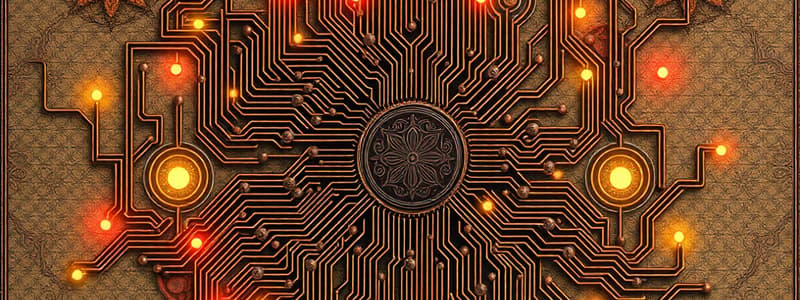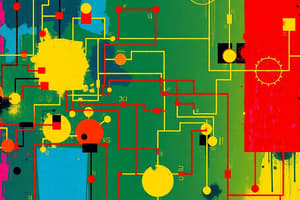Podcast
Questions and Answers
What characteristic distinguishes an ideal voltage source from a practical voltage source?
What characteristic distinguishes an ideal voltage source from a practical voltage source?
- It has some internal resistance. (correct)
- It maintains a constant voltage. (correct)
- It has infinite resistance in series.
- It can vary its voltage with load.
Which of the following statements about ideal current sources is true?
Which of the following statements about ideal current sources is true?
- They can only provide current up to a certain limit.
- They maintain a constant current regardless of the load. (correct)
- They supply current based on the resistance of the load.
- They provide voltage independent of load.
If an ideal current source supplies 300mA to a load of 1kΩ, what will the load current be if the load is changed to 100Ω?
If an ideal current source supplies 300mA to a load of 1kΩ, what will the load current be if the load is changed to 100Ω?
- 3A
- 30mA
- 100mA
- 300mA (correct)
What is the defining feature of a dependent source?
What is the defining feature of a dependent source?
Which statement accurately describes a practical current source?
Which statement accurately describes a practical current source?
What characterizes an active network?
What characterizes an active network?
Which statement is true regarding current flow in passive elements?
Which statement is true regarding current flow in passive elements?
What is the power absorbed by an element when the current is -2A and the voltage is -3V?
What is the power absorbed by an element when the current is -2A and the voltage is -3V?
Which of the following best describes a branch in a network?
Which of the following best describes a branch in a network?
Which statement is correct about voltage definition across an element?
Which statement is correct about voltage definition across an element?
How is the direction of positive current flow characterized?
How is the direction of positive current flow characterized?
What distinguishes a node in a network?
What distinguishes a node in a network?
When is power considered to be supplied by an element?
When is power considered to be supplied by an element?
What type of circuit element is defined as one that can supply an average power over an infinite time interval?
What type of circuit element is defined as one that can supply an average power over an infinite time interval?
Which circuit element is independent of the current flowing through it?
Which circuit element is independent of the current flowing through it?
Which of the following statements about passive elements is true?
Which of the following statements about passive elements is true?
What distinguishes a practical source from an ideal source?
What distinguishes a practical source from an ideal source?
Which component is classified as a passive element that can store energy?
Which component is classified as a passive element that can store energy?
What is the relationship of voltage across a resistor to the current through it?
What is the relationship of voltage across a resistor to the current through it?
Which of the following best describes a dependent voltage source?
Which of the following best describes a dependent voltage source?
What term refers to the essential circuit concepts such as node, path, loop, and branch?
What term refers to the essential circuit concepts such as node, path, loop, and branch?
Study Notes
Circuit Elements
- Circuit elements define relationships between current and voltage.
- If voltage is proportional to current, the element is a resistor.
- Key components include:
- Independent voltage source (current independent)
- Dependent current source (dependent on current elsewhere)
- Inductor (derivative of current)
- Capacitor (integral of current)
Active & Passive Circuit Elements
- Active elements supply average power (>0), e.g., ideal sources.
- Passive elements cannot provide average power (>0), e.g., resistors, capacitors, inductors.
- Resistor dissipates energy; capacitors and inductors store and release energy.
Ideal & Practical Sources
- Ideal sources provide constant voltage or current, unaffected by circuit elements.
- Ideal voltage sources have zero internal resistance; ideal current sources have infinite internal resistance.
- Practical sources model ideal sources with internal resistance in series or parallel.
Independent & Dependent Sources
- Independent sources maintain constant voltage or current regardless of circuit conditions.
- Dependent sources have values proportional to other circuit parameters.
- Types include:
- Voltage-controlled voltage source (VCVS)
- Current-controlled current source (CCCS)
- Types include:
Network & Circuits
- Networks connect two or more circuit elements; a network becomes a circuit when it has a closed path.
- Active networks contain at least one active source (voltage or current).
- Passive networks lack any active sources.
Reference Directions
- Voltage requires labeling of terminals (+ and -).
- Current flow requires a defined direction, using arrows for clarity.
- Current directionality:
- Flows from higher to lower potential in passive elements.
- Flows from lower to higher potential in active elements.
- Power relationships:
- Positive current out of positive terminal indicates power supply.
- Positive current into positive terminal indicates power absorption.
Network Terminologies
- Node: connection point for two or more circuit elements.
- Branch: a single path with one element and nodes at each end.
- Path: movement from one node to another without repeating nodes.
Studying That Suits You
Use AI to generate personalized quizzes and flashcards to suit your learning preferences.
Related Documents
Description
This quiz covers the fundamentals of Electrical Engineering as introduced in Lecture 1. Key topics include circuit elements, sources, and their classifications, alongside active and passive circuits. Numerical examples are also provided to enhance understanding.




